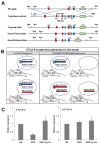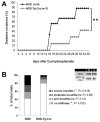The B7-independent isoform of CTLA-4 functions to regulate autoimmune diabetes
- PMID: 23293354
- PMCID: PMC3568535
- DOI: 10.4049/jimmunol.1201362
The B7-independent isoform of CTLA-4 functions to regulate autoimmune diabetes
Abstract
The critical role of CTLA-4 in inhibiting Ag-driven T cell responses upon engagement with its ligands, B7-1 and B7-2 and its importance for peripheral T cell tolerance and T cell homeostasis has been studied intensively. The CTLA-4 splice variant ligand-independent (li)-CTLA-4 is expressed in naive and activated T cells and can actively alter T cell signaling despite its lack of a B7 binding domain. To study the effect of li-CTLA-4 in regulating T cell responses in the context of autoimmunity, we engineered a B6.CTLA-4 (floxed-Exon2)-BAC-transgene, resulting in selective expression of li-CTLA-4 upon Cre-mediated deletion of Exon 2. Introducing the B6.BAC into the NOD background, which is genetically deficient for li-CTLA-4, restores mRNA levels of li-CTLA-4 to those observed in C57BL/6 mice. Furthermore, re-expressing this ligand nonbinding isoform in NOD mice reduced IFN-γ production in T effector cells accompanied by a significant decrease in insulitis and type 1 diabetes frequency. However, selective expression of li-CTLA-4 could not fully rescue the CTLA-4 knockout disease phenotype when bred onto NOD.BDC2.5.CTLA-4 knockout background because of the requirement of the full-length, B7-binding CTLA-4 molecule on T effector cells. Thus, the li-CTLA-4 form, when expressed at physiologic levels in the CTLA-4-sufficient NOD background can suppress autoimmunity; however, the functionality of the li-CTLA-4 isoform depends on the presence of the full-length molecule to alter effector T cell signaling.
Figures






References
-
- Fife BT, Bluestone JA. Control of peripheral T-cell tolerance and autoimmunity via the CTLA-4 and PD-1 pathways. Immunol Rev. 2008;224:166–182. - PubMed
-
- Scalapino KJ, Daikh DI. CTLA-4: a key regulatory point in the control of autoimmune disease. Immunol Rev. 2008;223:143–155. - PubMed
-
- Gough SC, Walker LS, Sansom DM. CTLA4 gene polymorphism and autoimmunity. Immunol Rev. 2005;204:102–115. - PubMed
-
- Holmberg D, Cilio CM, Lundholm M, Motta V. CTLA-4 (CD152) and its involvement in autoimmune disease. Autoimmunity. 2005;38:225–233. - PubMed
Publication types
MeSH terms
Substances
Grants and funding
LinkOut - more resources
Full Text Sources
Other Literature Sources
Medical
Molecular Biology Databases

